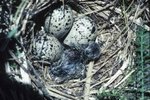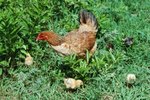While French Marans chickens are relatively rare in North America, the cuckoo types are among the best-known on these shores. Cuckoo has nothing to do with clocks or mental states, but is a sex-linked color variant in the breed.
Silver and Gold Cuckoos
The cuckoo variety of Marans appear in silver and gold. In the U.S., the silver version is more readily available through commercial hatcheries. The breed resembles the much more common barred rock, with feathers crossed with either gray or golden brown bars in an irregular pattern. This is a single-combed breed, with no leg feathering. Even as chicks, the male and female cuckoo marans are easily differentiated, as females are darker than males. At maturity, the cuckoo Marans weigh between 7 and 8 pounds. In general, the Marans is a somewhat passive bird, neither nervous nor aggressive.
Other Maran Colors
Ordinary Marans chickens -- non-cuckoo -- appear in various shades. These include:
- white, buff and wheaten
- black, silver black and black-tailed buff
- blue
- coppers -- red chickens with additional blue, black or splashes of color
Egg Color and Production
- While many types of hens lay brown eggs, the Marans' eggs are a deep, rich chocolate color. Some cuckoo Marans hens will lay darker eggs than others. Generally, younger birds lay darker eggs than older ones. Some eggs are solid brown, while others sport spots.
- The average cuckoo Marans hen lays three eggs weekly from spring until fall. If you light your chicken coop for winter laying, the Marans will lay year round. The eggs are not just dark, but especially large. Cuckoo Marans hens will go broody, so you can raise chicks naturally, if desired.
Tips
If you intend to raise chicks, it's advisable to have a rooster-to-hen ratio of 1 to 8 or so -- fewer hens than it typical for most breeding roosters.
Cold-Weather Cluckers
While some chicken breeds don't do well in cold climates, that's not the case with the cuckoo Marans. They do well in confinement and are a good choice if your chicken-keeping doesn't permit free-ranging.
Writer Bio
Jane Meggitt has been a writer for more than 20 years. In addition to reporting for a major newspaper chain, she has been published in "Horse News," "Suburban Classic," "Hoof Beats," "Equine Journal" and other publications. She has a Bachelor of Arts in English from New York University and an Associate of Arts from the American Academy of Dramatics Arts, New York City.




